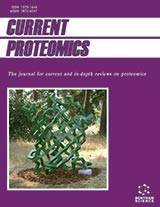Abstract
Background: Aspergillus terreus is a major etiological agent among fungal pathogens and emerged as an opportunistic pathogen in immunocompromised patients.
Objective: To explore mycelial proteins to shed light on chemical and molecular details that contribute to pathogenesis including intrinsic resistant to amphotericin B (AmB), and biomolecules associated with biofilm formation.
Methods: The mycelial proteins of A. terreus cultured for 48h at 37°C have been analysed by using nLC-ESI-MS/MS. Protein data analysis performed by Proteome Discoverer (V/2.2) against the UniProt database. Also, Scanning Electron Microscopy (SEM) analysis of biofilm formation under optimum conditions was carried out. qRT-PCR was carried out for genes encoding for functionally important proteins.
Results: A total of 389 proteins were detected at FDR 0.01. Gene ontology showed the abundance of proteins from energy metabolism, cellular homeostasis, ribosome biogenesis, cell wall, and structural components. We observed catalase, superoxide dismutase, thioredoxin, glutathione S-transferase involved in redox homeostasis and heat shock proteins (Hsp90 and Hsp70). These proteins may provide insight into the resistance mechanism of A. terreus against AmB. Additionally, SEM analysis of A. terreus showed the formation of dense hyphal network covered with porous extracellular matrix (ECM). Using SECRETOOL, 8 proteins were predicted as secretory. Three proteins, such as glucanase Crf1/allergen (Asp F9), 1, 3-β-glucanosyltransferase and β-hexosaminidase were reported in biofilm establishment.
Conclusion: Our proteome data provided experimental evidence to the annotated set of proteins in A. terreus that comprehend biochemical and cellular events involved in the establishment of mycelial network and contributing to the pathogenesis. This work also provides resource for further molecular studies in A. terreus.
Keywords: Amphotericin B resistance, extracellular matrix, secretory proteins, adhesion, biofilm, HPV.
Graphical Abstract
Current Proteomics
Title:Exploration of Mycelial Proteins from Aspergillus terreus Revealed Ribosome Biogenesis and Antioxidant Enzymes
Volume: 17 Issue: 5
Author(s): Sonia Kumari Shishodia and Jata Shankar*
Affiliation:
- Genomics Laboratory, Department of Biotechnology and Bioinformatics, Jaypee University of Information Technology, Solan-173234 (Himachal Pradesh),India
Keywords: Amphotericin B resistance, extracellular matrix, secretory proteins, adhesion, biofilm, HPV.
Abstract:
Background: Aspergillus terreus is a major etiological agent among fungal pathogens and emerged as an opportunistic pathogen in immunocompromised patients.
Objective: To explore mycelial proteins to shed light on chemical and molecular details that contribute to pathogenesis including intrinsic resistant to amphotericin B (AmB), and biomolecules associated with biofilm formation.
Methods: The mycelial proteins of A. terreus cultured for 48h at 37°C have been analysed by using nLC-ESI-MS/MS. Protein data analysis performed by Proteome Discoverer (V/2.2) against the UniProt database. Also, Scanning Electron Microscopy (SEM) analysis of biofilm formation under optimum conditions was carried out. qRT-PCR was carried out for genes encoding for functionally important proteins.
Results: A total of 389 proteins were detected at FDR 0.01. Gene ontology showed the abundance of proteins from energy metabolism, cellular homeostasis, ribosome biogenesis, cell wall, and structural components. We observed catalase, superoxide dismutase, thioredoxin, glutathione S-transferase involved in redox homeostasis and heat shock proteins (Hsp90 and Hsp70). These proteins may provide insight into the resistance mechanism of A. terreus against AmB. Additionally, SEM analysis of A. terreus showed the formation of dense hyphal network covered with porous extracellular matrix (ECM). Using SECRETOOL, 8 proteins were predicted as secretory. Three proteins, such as glucanase Crf1/allergen (Asp F9), 1, 3-β-glucanosyltransferase and β-hexosaminidase were reported in biofilm establishment.
Conclusion: Our proteome data provided experimental evidence to the annotated set of proteins in A. terreus that comprehend biochemical and cellular events involved in the establishment of mycelial network and contributing to the pathogenesis. This work also provides resource for further molecular studies in A. terreus.
Export Options
About this article
Cite this article as:
Shishodia Kumari Sonia and Shankar Jata *, Exploration of Mycelial Proteins from Aspergillus terreus Revealed Ribosome Biogenesis and Antioxidant Enzymes, Current Proteomics 2020; 17 (5) . https://dx.doi.org/10.2174/1570164617666191004163734
| DOI https://dx.doi.org/10.2174/1570164617666191004163734 |
Print ISSN 1570-1646 |
| Publisher Name Bentham Science Publisher |
Online ISSN 1875-6247 |
 16
16
- Author Guidelines
- Bentham Author Support Services (BASS)
- Graphical Abstracts
- Fabricating and Stating False Information
- Research Misconduct
- Post Publication Discussions and Corrections
- Publishing Ethics and Rectitude
- Increase Visibility of Your Article
- Archiving Policies
- Peer Review Workflow
- Order Your Article Before Print
- Promote Your Article
- Manuscript Transfer Facility
- Editorial Policies
- Allegations from Whistleblowers
























